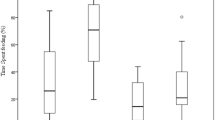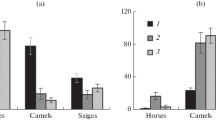Abstract
I provide the first comprehensive data on the composition and mineral content of exudates eaten by saddleback (Saguinus fuscicollis) and mustached tamarins (S. mystax) and assess Garber's (1984; 1993) hypotheses on the potential nutritional importance of exudates in the diet of tamarins. In accordance with his initial findings, nutritional analyses show that the gums consumed are relatively high in calcium and may serve to balance a diet otherwise low in this mineral and high in phosphorus. However, the data on the seasonal variation in the amount consumed do not support the hypothesis that exudates are of particular nutritional importance during the later stages of gestation or lactation for saddleback or mustached tamarins.
Similar content being viewed by others
REFERENCES
Anderson, D. M. W., and Leon de Pinto, G. (1980). Variations in the composition and properties of the gum exuded by Acacia karroo hayne in different African locations. Botan. J. Linnean Soc. 80: 58-89.
Anderson, D. M. W., and Leon de Pinto, G. (1985). Gum polysaccharides from three Parkia species. Phytochemistry 24: 77-79.
Anderson, D. M. W., Weiping, W., and Lewis, G. P. (1990). The composition and properties of eight gum exudates (Leguminosae) of American origin. Biochem. System. Ecol. 18: 39-42.
Bearder, S. K., and Martin, R. D. (1980). Acacia gum and its use by lesser bushbabies, Galago senegalensis (Primates: Lorisidae). Int. J. Primatol. 1: 103-128.
Boulay, G. H., and Crawford, M. A. (1968). Nutritional bone disease in captive primates. Symp. Zool. Soc. Lond. 21: 223-236.
Dawson, G. A. (1976). Behavioural ecology of the Panamanian tamarin, Saguinus oedipus geoffroyi (Primates: Callitrichidae), Unpublished PhD thesis, Michigan State University, East Lansing, Michigan.
Danowski, T. S. (1962). Clinical Endocrinology, Vol. 3: Calcium, Phosphorus, Parathyroids, and Bone, Williams and Wilkins, Philadelphia.
Engfeldt, B. (1950). Studies on parathyroidal function in relation to hormone influences and dietetic conditions. Acta Endocrinol. 6: (Suppl) 1-18.
Engfeldt, B., Hjertquist, S. O., and Strandh, J. R. E. (1954). The parathyroidal function in long-term dietary experiments. Acta Endocrinol. 15: 119-128.
Garber, P. A. (1984). Proposed nutritional importance of plant exudates in the diet of the Panamanian tamarin, Saguinus oedipus geoffroyi. Int. J. Primatol. 5: 1-15.
Garber, P. A. (1993). Feeding ecology and behaviour of the Genus Saguinus. In Rylands A. B. (ed.), Marmosets and Tamarins: Systematics, Ecology, and Behaviour, Oxford University Press, Oxford, UK, pp. 273-295.
Howes, F. N. (1949). Vegetable Gums and Resins, Chronica Botanica Company, Waltham, MA.
King, G. J. (1978). Comparative feeding and nutrition in captive nonhuman primates. Br. J. Nutr. 40: 55-62.
Krook, L., and Barrett R. B. (1962). Simian bone disease-secondary hyperparathyroidism. Cornell Vet. 52: 459-592.
Leon de Pinto, G., Martinez, M., Gutierrez de Gotera, O., Vera, A., Rivas, C., and Ocando, E. (1995). Comparison of two Pithecellobium gum exudates. Biochem. Syst. Ecol. 23: 849-853.
Leon de Pinto, G., Martinez, M., Mendoza, J. A., Ocando, E., and Rivas, C. (1995). Comparison of three Anacardiaceae gum exudates. Biochem. Syst. Ecol. 23: 151-156.
Leon de Pinto, G., Martinez, M., Ortega, S., Villavicencio, N., and Borjas, L. (1993a). Composition of gum specimens from Acacia tortuosa and other Gummiferae species. Biochem. Syst. Ecol. 21: 795-797.
Leon de Pinto, G., Rodriguez, O., Martinez, M., and Rivas, C. (1993b). Composition of Cercidium praecox gum exudates. Biochem. Syst. Ecol. 21: 297-300.
Martinez, M., Leon de Pinto, G., Alvarez, S., Gonzalez de Troconis, N., Ocando, E., and Rivas, C. (1995). Composition and properties of Albizia lebbeck gum exudate. Biochem. Syst. Ecol. 23: 843-848.
Maynard, L. A., and Loosli, J. K. (1969). Animal Nutrition, 6th ed, McGraw-Hill, New York.
Nash, L. T. (1986). Dietary, behavioural, and morphological aspects of gummivory in primates. Yearbook Phys. Anthrop. 29: 113-137.
Nash, L. T., and Whitten, P. L. (1989). Preliminary observations on the role of Acacia gum chemistry in Acacia utilization by Galago senegalensis in Kenya. Am. J. Primatol. 17: 27-39.
Nickle, D. A., and Heymann, E. W. (1996). Predation on Orthoptera and other orders of insects by tamarin monkeys, Saguinus mystax mystax and Saguinus fuscicollis nigrifrons (Primates: Callitrichidae), in northeastern Peru. J. Zool. Lond. 239: 799-819.
Peres, C. A. (1991). Ecology of Mixed-Species Groups of Tamarins in Amazonian Terra Firme Forests. Unpublished PhD thesis, University of Cambridge, UK.
Power, M. L. (1991). Digestive Function, Energy Intake, and the Response to Dietary Gum in Captive Callitrichids, PhD thesis, University of California, Berkeley.
Robinson, C. H. (1980). Basic Nutrition and Diet Therapy, 4th ed, Macmillan, New York.
Silver, S. C. (1997). The Feeding Ecology of Translocated Howler Monkeys, Unpublished PhD Dissertation, Fordham University, Bronx, New York.
Smith, A. C. (1997). ComparativeEcology of Saddleback (Saguinus fuscicollis) and Moustached (Saguinus mystax) Tamarins, PhD. thesis, The University of Reading, Reading, UK.
Snowdon, C. T., and Soini, P. (1988). The tamarins, genus Sauinus. In Mittermeier, R. A., Rylands, A. B., Coimbra-Filho, A., and Fonseca, G. A. B. (eds.), Ecology and Behaviour of Neotropical Primates. Vol. 2, World Wildlife Fund, Washington, DC, pp. 223-298.
Snyder, S. B., Omdahl, J. L., Law, D. H., and Froelich, J. W. (1980). Osteomalacia and nutritional secondary hyperparathyroidism in a semi-free-ranging troop of Japanese monkeys. In Montali, R. J., and Migaki, G. (eds.), The Comparative Pathology of Zoo Animals, Smithsonian Institution Press, Washington, DC, pp. 59-64.
Terborgh, J. (1983). Five New World Primates: A Study in Comparative Ecology. Princeton University Press, Princeton.
Tomson, F. N., Keller, G. L., and Knapke, F. B. (1980). Nutritional secondary hyperparathy-roidism in a group of lemurs. In Montali, R. J., and Migaki, G. (eds.), The Comparative Pathology of Zoo Animals, Smithsonian Institution Press, Washington, DC, pp. 59-64.
Uvarov, B. (1966). Grasshoppers and Locusts: A Handbook of General Acridology, Vol. 1, Cambridge University Press, Cambridge, UK.
Wrangham, R. W., and Waterman, P. G. (1981). Feeding behavior of Vervet monkeys on Acacia tortilis and Acacia xanthophloea: With special reference to reproductive strategies and tannin production. J. Anim. Ecol. 50: 715-731.
Author information
Authors and Affiliations
Rights and permissions
About this article
Cite this article
Smith, A.C. Composition and Proposed Nutritional Importance of Exudates Eaten by Saddleback (Saguinus fuscicollis) and Mustached (Saguinus mystax) Tamarins. International Journal of Primatology 21, 69–83 (2000). https://doi.org/10.1023/A:1005423629627
Issue Date:
DOI: https://doi.org/10.1023/A:1005423629627




